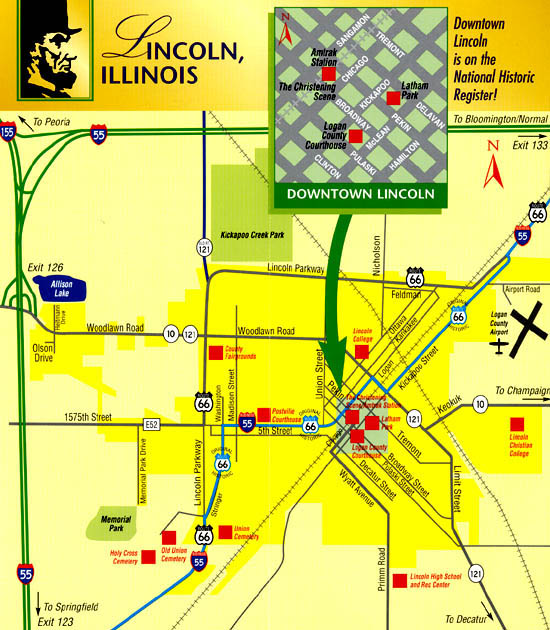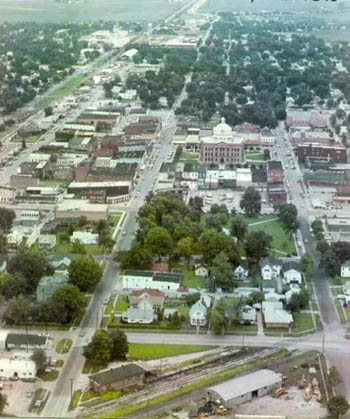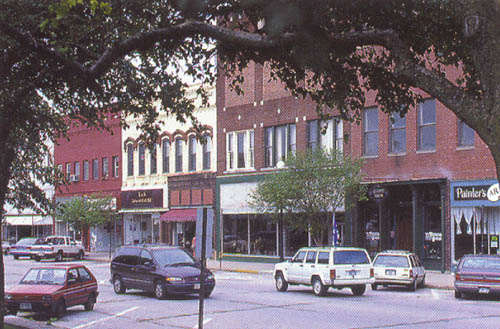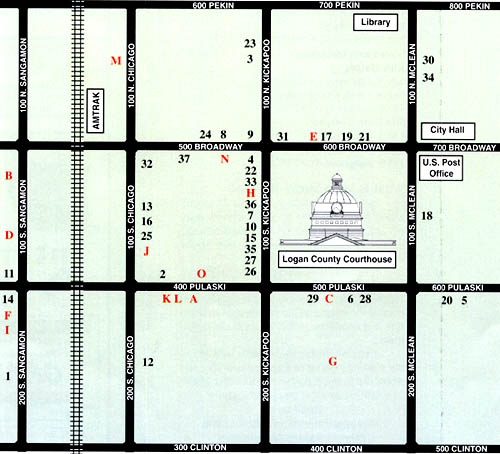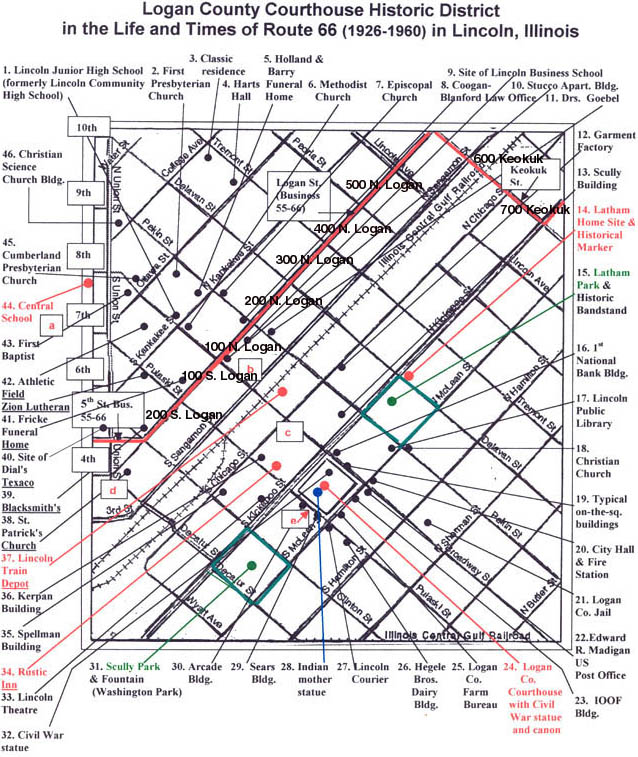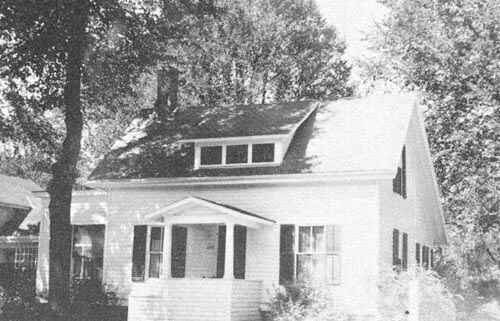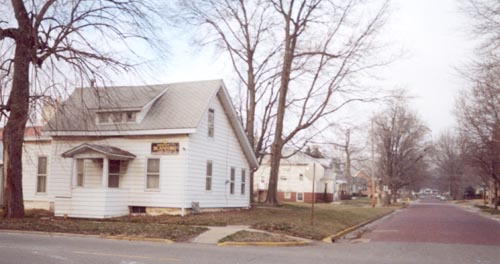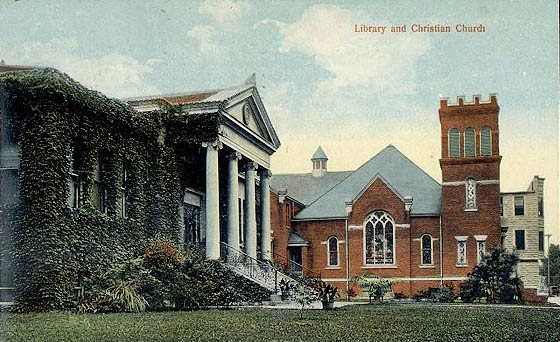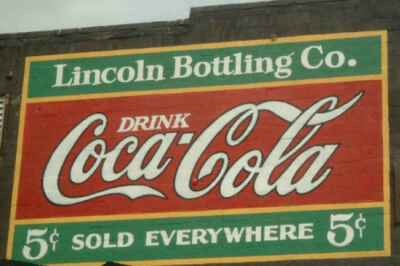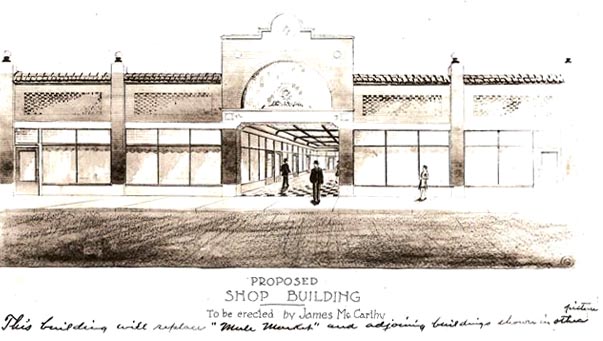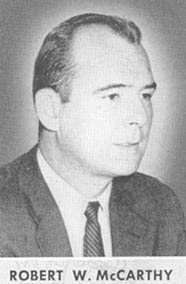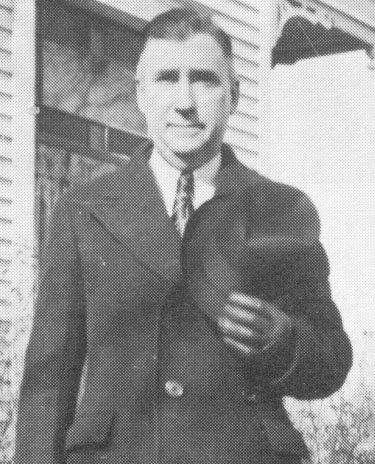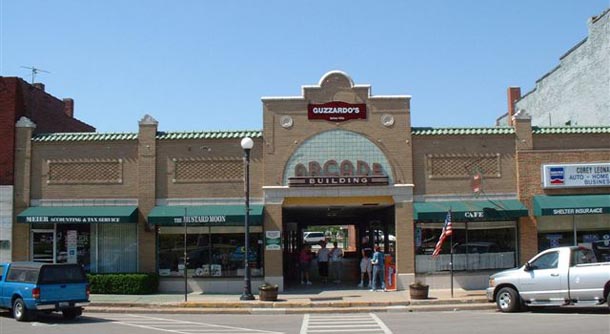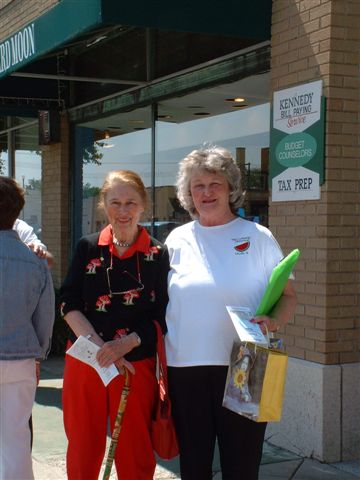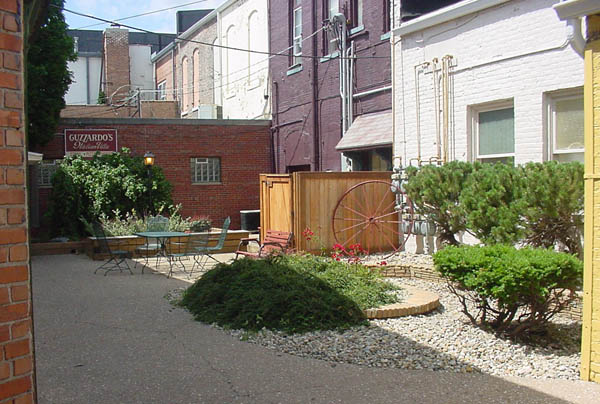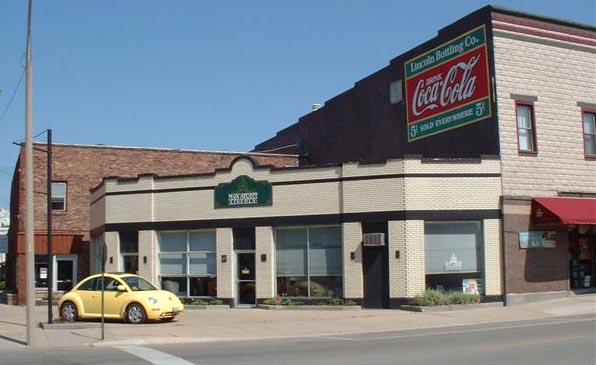
1860 photo taken 4 days after Mr.
Lincoln visited Lincoln, Illinois, for the last time. Info at 3 below.
This President
grew;
His town does too.
Link to Lincoln:
Lincoln & Logan County Development Partnership
Site
Map
Testimonials
Abraham Lincoln Bicentennial Commission of Lincoln, IL
|
Email a link to this page to someone who might be interested.
Internet Explorer is the only browser that shows this page the way it was designed.
Your computer's settings may alter the display.
April 24,
2004: Awarded "Best Web Site of the Year" by the Illinois State Historical
Society
|
|
Marquee Lights of the Lincoln Theater, est. 1923, Lincoln, Illinois |
|
|
|
14. Sightseeing, Shopping, and Dining in the Logan County Courthouse Square Historic District, Including Locations of Historical Markers The entire Lincoln-Logan County Courthouse Square Historic District is on the National Register of Historic Places. Access a summary of the official description of the Lincoln-Logan County Courthouse Square Historic District (PDF) (document, courtesy of Pat Freese). Below you will find:
|
|
14.1: Overview Map of Lincoln, Illinois, Showing Location of Downtown (Map by the Abraham Lincoln Tourism
Bureau of Logan County:
http://www.logancountytourism.org) Logan County Genealogical & Historical Society in Downtown Lincoln One of the most important sources of information of interest to visitors of downtown Lincoln is the Logan County Genealogical & Historical Society, located at 114 N. Chicago St. (across from the former railroad station, now the Depot Restaurant). The Society provides access to collections of Logan County family histories, local history books, maps, obituaries, cemetery records, records of birth, marriage, surnames, and more. The Society's facilities include the Abe Lincoln Room, which contains over 125 books about Mr. Lincoln, memorabilia, as well as several busts and photos of him. Access the Society's flier and Web site for more information.
14.2: Aerial View of the Logan
County Courthouse Square (undated photo courtesy of Fred Blanford. Click image for larger version.) Fred Blanford emailed this photo (3-17-04), noting: "This is the scan of a picture I came across that I liked because of the 'long view' it gives of Kickapoo Street right on out to old 66. The time references have me a little confused. The new First National Bank is there; Spurgeon's and Woolworth's are both present, but it looks like the Miller Building has not yet burned--northwest of the library." Does this photo date to the early 1970s? Since it was taken, several businesses have passed away, and several historic structures have been sacrificed to "progress": for example, the ICC freight depot in the foreground and the Stetson China Company (and water tower) in the background. The "bottle factory" remains. How many sites can you identify, Lincolnites at Heart?
14.3: Present-Day Shops Along Kickapoo Street on the Historic Logan County Courthouse Square (photo from Lincoln/Logan County
Chamber of Commerce |
|
Map of Downtown Lincoln with Sites for Shopping and Dining
14.4: Downtown Lincoln Shopping and Dining (map by Main Street Lincoln: http://www.mainstreetlincoln.com) Main Street Lincoln is a non-profit organization formed in 1994 by local business owners and residents who are interested in the economic stability and revitalization of the downtown Logan County Courthouse Square Historic District. The national Main Street Program, established in 1980 by the National Trust for Historic Preservation, combats the threats to the commercial architecture and to the economic well-being of small-city downtowns. Email Main Street Lincoln at [email protected]. Numbers and
letters of items below correspond to map locations above. |
|
|
Shopping 1. AMP Studio. 205 S. Sangamon St. 217-735-9939 2. All About You. 408 Pulaski St. 217-735-4700 3. Abe's Carmel Corn. 117 N. Kickapoo St. 217-732-4564 http://www.abesinc.com 4. Action Rentals & Home Furnishing Center. 101 S. Kickapoo St. 217-735-2333 5. Advanced Eye Care. 623 Pulaski St. 217-732-9606 6. B & K Antiques & Collectibles. Arcade Plaza, 513 Pulaski St. 217-732-4900 7. Beans & Such. 115 S. Kickapoo St. 217-735-5520. http://www.beansandsuch.com 8. Beecher's Jewelry. 520 Broadway Street. 217-732-4362 9. Cape Landing Salon. 528 Broadway St. 217-732-8531 or 735-4247 10. Cherished Memories. 117 S. Kickapoo St. 217-735-4186 11. Closet Classics. 129 S. Sangamon St. 217-735-9151 12. Curiosity Shop. 206 S. Chicago St. Elegant Creations. 121 S. Sheridan St. 217-733-5599 13. Fabulous Hair Styles & Tanning. 108 S. Chicago St. 217-732-4329 14. FranzExpress Copy & Parcel Depot. 201 S. Sangamon St. 217-732-3399 15. Forget Me Not Florals. 117 S. Kickapoo St. 217-735-2725 16. Forte Hair Salon. 110 S. Chicago St. 217-732-4329 17. Kathleen's Hallmark. 610 Broadway St. 217-732-7504 18. Lincoln Antique & Furniture Center. 112 S. McLean St. 217-732-2000 19. MKS Jewelers, LTD. 614 Broadway St. 217-732-6520 20. Marti's Family Hair Center. 617 Pulaski St. 217-732-6821 Mirror Image. 118 S. Hamilton St.
217-732-9151 |
Shopping (continued) Mustard Moon. 1314 5th St. 217-735-1093. 22. Now & Then Books. 107 S. Kickapoo St. 217-732-5672 23. Prairie Years. 121 N. Kickapoo St. 217-732-9216 Pete's Hardware. 203 S. Logan St. 217-735-2918 24. Prairie Eye Center. 518 Broadway St. 217-732-6062 25. Red Barn Antiques. 114 S. Chicago St. 217-732-2523 26. Serendipity Stitches & Custom Framing. 129 S. Kickapoo St. 217-732-8811 27. Sew Many Friends. 127 S. Kickapoo St. 217-732-4527 28. Sherwin Williams Co. 523 Pulaski St. 217-732-9222 29. Sports Plus. 511 Pulaski St. 217-735-1820 30. Sugar Creek Essentials. 116 N. McLean St. 217-735-5595 31. That Place, Inc./Merle Norman. 600 Broadway St. 217-732-6406 32. The Award Shop. 501 Broadway St. 217-735-5422 33. The Treasure Chest. 109 S. Kickapoo St. 217-735-3103 34. The Pink Shutter Thrift Shop. 114 N. McLean St. 217-732-2944 35. Three Roses Floral. 123 S. Kickapoo St. 217-732-3116 36. Wibben Computers. 113 S. Kickapoo St. 217-732-5904 Whit's Lawn Center. 325 S. Chicago St. 217-735-3206 37. Glenn Brunk Stationers. 511 S. Broadway St. 217-735-9959 Bright Idea Screen Printing. 225 Clinton St. 217-732-3312
|
|
Dining A. Alley-Bi Saloon. 415 Pulaski St. 217-732-3630 B. Blue Dog Inn. 111 S. Sangamon St. 217-735-1743. http://www.bluedoginn.com. Highly recommended by Leigh Henson from personal dining experience 10-05. Excellent food, service, and atmosphere. C. Brandt's Arcade Cafe. 513 Pulaski St. 217-735-1443 D. Capone's. (New owners as of 10-05).121 S. Sangamon St. Phone for Capone's, Elizabeth's, and Wodunit Productions of Mystery Ink Dinner Theater: 217-732-6102. Capone's has a menu of appetizers, also entertainment. Elizabeth's Tea-Lunch Room and Receptions. 123 S. Sangamon St. Same owners as Capone's. Wide array of tea room fare as well as hearty lunches for men. Open Tues.--Sat. 11:00 a.m. to 2 p.m. and other times for full-service catering, private events, children's parties, specialty teas and receptions. Elizabeth's is the home of the Interactive Wodunit Productions of Mystery Ink Dinner Theater: www.mysteryinkproductions.com. Email: [email protected]. E. Cookie's Bakery. 604 Broadway St. 732-735-9955 F. Einstein's
Louisiana Coffee House. 201 S. Sangamon St. 217-735-5282 G. Guzzardo's Italian Villa. 509 Pulaski St. 217-732-6370. Highly recommended by Leigh Henson from personal experience 8-03. H. Hallie's Lunch Box. 111 S. Kickapoo St. 217-732-6923. Schnitzel highly recommended by Leigh Henson from personal experience 10-05. Tastes like the original, served in the old Mill beginning in 1945. Idle Hour Inn. 404 Broadway St. 217-732-9925 I. Internet Cafe. 201 S. Sangamon St. 217-735-5282 J. J & C Pour House. 122 S. Chicago St. 217-735-1095 K. Joe's Pizzeria. 409 Pulaski St. 217-732-3553 L. Mary's Place. 413 Pulaski St. 217-732-2241 M. McCarty's at the Depot. 101 N. Chicago St. 217-735-3314 N. Sam Sorrento's Ristorante. 521 Broadway St. 217-735-1442 O. Vintage Fair. 414 Pulaski St.
217-732-5737 |
|
|
Lincoln's Downtown Route 66 Streets and 51 Sites, Including Historical Markers
|
|
This map identifies 51 sites of interest, including locations of historical markers. On the map, the locations with historical markers are in red: 14, 24, 34, 37, and 44 and a, b, c, d, and e. Most of the historic places identified on this page are featured on other pages of this Web site with more descriptions and photos.
The streets of Business Route 66 seen on the map below are Fifth Street,
Logan Street, Keokuk Street, and Kickapoo Street. They are marked in
red, as they are on other maps in this Web site. |
|
(map by Leigh Henson) |
|
Listed below are the
downtown Lincoln locations with historical markers.
Note: During the Route 66 era, number 28 on the map above, the
Indian mother statue with drinking fountain, was located on the northwest
side of the courthouse about midway between the curb and the entrance (near
the Civil War statue). |
|
14. Site of Robert Latham home, 400 N. Kickapoo
St. |
|
24. Logan
County Courthouse, 1905 structure. The
present courthouse replaced an 1858 structure, which had replaced an 1856
building, destroyed by fire April 15, 1857. |
|
34.
Rustic Inn, 412 Pulaski St. Site of 1876 alleged
plot to steal the body of Abraham Lincoln from the first tomb in Oak Ridge
Cemetery at Springfield, Illinois. |
|
37.
Lincoln Train Depot and Town Christening Site, Broadway and
Chicago Streets. |
|
44. Central School, Eighth and Union Streets. Attended by African-American Poet Langston Hughes, who allegedly wrote his first poem here. Large plaque about Hughes at northeast corner of this site. Also attended by William Maxwell, 40-year editor of the
New Yorker magazine and author of novels and short stories set in
Lincoln, Illinois. |
|
a.
St. John United Church of Christ, 204 7th Street.
Church associated with the Niebuhrs, who were leading pastors, theologians,
authors, and professors in higher education. Plaque about the Niebuhrs
is
located on the east side of the church. |
|
b.
The State Bank of Lincoln,111 N. Sangamon Street.
Bank lobby displays signed copies of Abraham Lincoln life masks by Leonard
Volk and original artwork by Lloyd Ostendorf. |
|
c.
Site of former Lincoln House Hotel, 501 Broadway Street.
Hotel visited by Abraham Lincoln. |
|
d. Site of
Stephen A. Douglas 1858 Senate campaign speech,
corner of Decatur and Sangamon Streets. Abraham Lincoln was in the
audience. |
|
e.
Site of lot owned by Abraham Lincoln, 523 Pulaski
Street. |
|
Additional Sites Identified on the Above Map of the Historic Business District Most of the rest of the numbered items from the map above are
depicted and described elsewhere in this Web site, including the Lincoln
Public Library (17 on map above), but below I present another image of this
magnificent structure. Many of the buildings on Route 66 streets are
residences, and many of the businesses of the Route 66 era are gone. |
|
8. Blanford-Coogan Law Office During the time of the celebration of the centennial of Lincoln, Illinois, the Lincoln Evening Courier featured photos and brief accounts of several historic houses in Lincoln. I obtained information about the Coogan House from a microfilm copy of the Courier dated September 3, 1953. Re-publishing a photo from a printout of a microfilm copy would not yield a high-quality photo, so at my request Fred Blanford emailed the good quality photo seen in 14.2. It shows the same photo that appeared in the Courier. Here is the caption for the Coogan House that accompanies its photo in the Courier: "The James Coogan Family Home, 131 N. Logan Street, was built in 1853 [the year of Lincoln's founding] on the lot purchased at the public sale of town lots August 29, 1853. The original foundation came from Rocky Ford and the lumber was hauled from Springfield. This house has been continuously owned and occupied by the members of the Coogan family for 100 years. Mrs. Coogan died in 1890 and Mr. Coogan in 1918 at the age of 88. They were the parents of nine children, most of whom spent their entire lives in Lincoln. A daughter, Mrs. Wm. Edwards, who before her marriage in 1896 was the principal of Washington School, now occupies the old home. Prior to the erection of the first Catholic Church in Lincoln in 1857, Mass was read in this home by visiting priests from Chicago, Springfield and Peoria" (p. 2).
14.6: The Coogan House in the 1950s (photo provided by Fred and Marge Blanford from family papers) At my
request Fred Blanford has provided some information about the Coogan House
(later the Blanford-Coogan Law Offices). Here is Fred's information
sent on October 14, 2002: |
|
14.7: Contemporary View of the Coogan House (photo by Leigh Henson, winter, 2001) Fred Blanford and David Coogan used the Coogan House for their law offices in the late Route 66 era. The photo above shows a law office sign. Fred summarizes the law-office history of the Coogan House: "from 1970 to 1985 it was the Blanford & Coogan Law Office while since 1985 it has been me alone -- as Dave 'retired' to the bench." Respond to Fred and Marge (Coogan) Blanford at [email protected]. In the above photo at the
right is Pekin Street, one of Lincoln's many remaining red-brick pavements.
Other historic structures identified on the above map are on this section of
Pekin Street seen in 14.5: 2. The First Presbyterian Church
(associated with figures mentioned in this Web site: the Brainerds,
John T. Burns, William Maxwell, Professor Chris Oglevee, Illinois Governor
Richard Oglesby, and the Wilson family), 5. The Holland & Barry Funeral
Home, and 7. the Episcopal Church (associated with William Foley) |
|
17. Lincoln Public Library
14.8: 1911 Picture
Postcard Showing the Lincoln Public Library (left), |
|
Lee's Cafe and Tap Room (gone) was located approximately in the 500 block of Keokuk. Later, the Colonial Restaurant was located on this site, and Gordon's Tap was located across the alley in the building seen at the right (behind the cafe sign--now all gone). The buildings of Lee's and Gordon's featured a Spanish design and stucco exterior, an unusual material for central Illinois buildings, but seen on several other Lincoln buildings and houses, for example, the GM & O Train Depot, the Christian Science Church, and the houses named Irendean and Suma Ray. These are cited elsewhere in this Web site. |
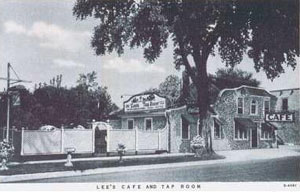
14.9: Lee's Cafe and Tap Room on |
|
Contemporary Renderings of Historic
Wall Ad Signs in the Historic District Note: The following photo and text are from The Courier in Lincoln, Illinois. They were passed on to me by someone who wishes to remain anonymous. If any reader knows the names of the photographer or reporter, please let me know so I can credit those sources more specifically here.
14.10: Lincoln Bottling
Co./Coca-Cola Reproduction on (photo from The Courier of Lincoln, Illinois) This sign appears on a building next to Main Street Lincoln, formerly the Sandels' gas station, which is depicted and described later on this page.
Anonymous source writes, quoting The Courier:
Yes,
the Letterheads were in town last month [8-04], and did a fantastic job of
brightening up our fair city. They were here about a week, were housed at
Lincoln College, were fed good meals by several cooperative efforts, and
left us with ten wonderful reminders of the good old days -- plus a
creation of their own, combining the best features of Lincoln, Ill. (to
them) on the back of the Lincoln Theatre wall. For information about the artists and photos of other wall ad signs in Lincoln, go to http://www.letterhead.com/meets/lincoln_04/ On that page also, don't miss this
additional link: |
|
|
Architectural Diversity in
the Logan County Courthouse Square Historic District Many of the buildings in the downtown Lincoln--Lincoln-Logan County Courthouse Square Historic District are 19th-century structures of classic, traditional design, but others are of distinctive 20th-century design, as indicated below. In May of 2007, in conjunction with National Historic Preservation Month, Main Street Lincoln, sponsored a walking tour of downtown Lincoln that "featured two structures erected by Lincoln businessman James McCarthy in the 1930s, and a significant parking lot behind one of the buildings" ("Strolling Through Lincoln's Past" by Nancy Rollings Saul, LincolnCourier.com, May 10, 2007). Mr. McCarthy's daughter, Frances McCormick and her son, Tim, provided information to Pat Freese and Deborah Short, who developed window displays for the tour and narrated it. Besides the Arcade, the tour focused on the building at the corner of Clinton and Kickapoo Streets. This building, previously owned by the McCarthys, was the site of the former Sandels' gas station in the 1940s and 1950s and is now the home of Main Street Lincoln. Carol Radespiel developed a brochure about the sites of this tour. The Arcade Building occupies the former Pulaski Street site of the Horse and Mule Market owned and operated by the popular horse veterinarian Dr. Thomas Donald (access details about Dr. Donald and his Horse and Mule Market). Mrs. Frances McCormick, a daughter of James McCarthy, who built the Arcade Building, notes that on this site in the early 1900s Dr. Donald had also had an outdoor movie theater called the Airdome. The documentation (nomination form) submitted to the US Department of the Interior for the Logan County Courthouse Square to be placed on the National Register of Historic Places Inventory provides background: "Following World War I, there was a loss of a number of the earlier Italianate Commercial structures, which were replaced or remodeled to make the business district appear to be more progressive. Several notable buildings were constructed during the period 1920--1932. These include the Italian Villa Style Lincoln Theater Building (207 S. Kickapoo), the Mission Style Arcade Building on the south side of the square, the Art Deco Marcucci Building on the northwest corner of the square, and the Art Deco Griesheim Building across the street north of the Marcucci Building" [Leigh's correction: the Griesheim Building is south of the Marcucci Building, not north]. "One individual who probably influenced the character and quality of the District more than any other person was architect John M. Deal. His firm, known as Deal & Ginzel (1890--1910) and John M. Deal, architect (1910--1948), was responsible for the original design or alteration of at least 20 buildings in the Logan County Courthouse Square Historic District prior to 1932." [Leigh's note: J.M. Deal's associate, Roland Ginzel, was probably the father of the Roland Ginzel who was born in Lincoln in 1921, who is an internationally known painter (Chicago Imagist School), and who was awarded an honorary doctorate from Lincoln College in 2000.] "John M. Deal was born in Sweetwater, Illinois, in 1867 and was a cabinet maker by trade in his early years. He began designing and constructing buildings and was one of the early architects to be grandfathered in under the Illinois Architectural Registration Act of 1897. In 1890 he teamed up with a professionally trained architect named Ginzel, who specialized in design as a complement to Deal's construction expertise. As was customary during this era, the firm's working drawings were drawn on linen in ink. Many of these working drawings are still on file with a Springfield architectural firm." "The most significant building in the District for which the firm was responsible is the Logan County Courthouse, which was completed in 1903. In addition to a number of remodelings, the firm also designed: the neo-classical First National Bank Building (1914) (now Kathleen's Hallmark Shop), the five-story I.O.O.F. Lodge just south of the post office (1915), the Arcade Building on the south side of the square (1929). The firm also designed over 50 residences in Lincoln, several schools and a hospital." [Leigh's note: John (J.M.) Deal was also the architect who designed the yellow-brick Lincoln High School of 1900 (where William Maxwell spent his freshman year) (Stringer, p. 428) and the two-story, red-brick Administration Building of Lincoln College in 1902, which burned January, 1969 (Beaver, History of Logan County 1982, p. 86)]. "Of
the 112 structures in the Lincoln-Logan County Courthouse Square Historic District,
only 23 have been constructed or extensively remodeled since 1940. This has
resulted in a District that appears much as it did in the early 1930s when
the automobile and housing patterns began to pull some of the commercial
growth away from downtown areas. The Courthouse Square Historic District,
then, maintains the character of a central commercial area that was largely
shaped during the era 1880--1932." |
|
|
14:11: Original Architectural Drawing of the Arcade Building (courtesy of the McCormicks and Pat Freese) This photo is hanging in Brandt's Cafe and is on loan from local attorney Warren Peters, who is very appreciative of Lincoln's history and culture. James McCarthy's daughter, Frances McCormick, told Pat Freese that in the late 1920 James McCarthy had made one of his rare trips away from Lincoln to visit St. Louis to see a newly designed building. The Arcade Building was constructed in 1929 as a one-story Mission Style structure with terracotta and tile trim. According to an undated letter from Frances McCormick and her son, Tim, "The design of the building was different, imaginative, and would have features distinct from those of other properties. It would be an arcade, with a lobby with a terrazo floor. It would have large glass double doors at either end so the lobby could be closed. Shops would open off the lobby." This letter also notes that the Arcade had a large glass sky light in the center of the ceiling and a large scale on the lobby floor so that people could weigh themselves. In the 1940s, James McCarthy's son, Father Thomas McCarthy, designed the terrace area that became the garden near the entrance to the restaurant founded by the Guzzardos in 1960. (In 2007, the Guzzardos own the Arcade Building.) The McCormicks' letter continues: "Citizens were truly excited about the construction. Its progress was watched with interest and pride. A year or so later the construction was finished, and the Depression was being felt. It was difficult to find business people who could afford to start a new shop. Mr. McCarthy went to some of his friends in the business world of Lincoln and made an offer: 'Come start a store in the Arcade. Pay no rent at first; when you start making money, pay rent.' Gus Marcucci, who owned a confectionary on Broadway, started a store; its successor, Brandt's Arcade Cafe is still in business. Albert Feldman owned a gift, paint, and wallpaper store on Kickapoo Street. He opened a gift store, which became Taylor's Store, owned by Leona and Bay Taylor. They were there many years also. Dr. Tilley, osteopath, evolved into Dr. James Coogan's office [dentistry] and after a lengthy time it became the office of Dr. Swan." "That first year was 'catch as catch can' and Christmas was coming. Mr. McCarthy went into the retail business in his own building and opened a toy store. The McCarthy children were quite familiar with toys they received from Santa that Christmas. Marge and Gene Doty established Doty's Jewelry Store in that location and were lifetime tenants." "The Arcade Coffee Shop owned by Art and Mandy Bree followed Marcucci's and has been occupied ever since. Eileen McNally owned and operated Arcade Beauty Shop for sixty years. Edna Dumser was an operator with her for several years. Another beauty shop owned by Herta Gleason opened across the lobby." "Dr. John Shute dentist, Robert W. McCarthy attorney, Arcade Loan Co. [Richard "Dick" Hayes], and James McCarthy Realty occupied space for many years. John McCullough was practicing law also in the McCarthy office. Roger Thompson, attorney, was a later tenant."
14.12: Representing the 47th
District in the 71st General Assembly with His (photo in the Illinois Blue Book, 1959--1960, p. 296) Access photos of Robert W. "Bob" McCarthy in the role of founding father Robert Latham during the 1953 historic centennial celebration re-enactment of the christening of Lincoln, Illinois (#37.22 and 23). Now, do you think Bob McCarthy was assigned to play the role of Robert Latham, or do you think there could have been a good reason for his wanting to choose to impersonate this particular founding father of the first Lincoln namesake town? Gentle reader (apologies to Nathaniel Hawthorne for using this mode of direct address), if you continue down this page far enough, you will have the answer. "Heights Finance and Crown Loan Co. spent time in the Arcade. Robert Prunty had a barber shop in the rear of the building and Merle Norman Cosmetics spent years in the rear rooms." "In the Pulaski Street rooms the tenants were Mr. and Mrs. Walter Sablotney in 1938. They purchased the shoeshine and shoe shop from Cecil Coffey in 1938. They ran the Arcade Shoe Shop for many years and then moved to the present location, which their son Terry operates. Deckers Shoe Store, established by Jim and Dorie Decker later had a long occupancy. Another early tenant on the right side of the street was the Morrow Sisters Dress Shop, owned by Ann and Nell Morrow. A shop called Fashion Flair, owned by Mr. Smith, followed. Leola Dowling had her art studio there for a time." "Next to Dotys' on the front of the Arcade, Dr. Jeffrey Fults started his optometry office and was there a lifetime. Dale Meier Accounting and Tax Service has been in the former Fults location for many years. Dr. Rogers, podiatrist, was there many years." "The annex to the Arcade was built in the 40s and became the location of Lincoln Sand and Gravel. Burchetts Photography Studio was on the first floor of the annex and the Guzzardos, Rose and Dominic, started their Italian restaurant upstairs in 1960. Before the Guzzardos occupied this site, James McCarthy used it for his art studio, and he designed the terrace in front of it. Guzzardos are still there and are the present owners of the Arcade complex." "Walter Spatz and Philip Reese followed Lincoln Sand and Gravel, and Dan Bock opened his first office in the annex."
[Leigh's note: many of the early and long-time occupants were friends of Mr.
McCarthy, and they were fellow Roman Catholics. Clothing stores owned by
Jewish families were located on the west side of the square: the Griesheims
on Kickapoo Street and the Landauers and Jacobses on the north side of the
square on Broadway Street.]
14:13: James McCarthy (1883--1952) (photo in Beaver, History of Logan County 1982, p. 643) Paul Beaver's History of Logan County 1982 includes the following entry submitted by Frances McCormick: "James McCarthy was born in Lincoln, Illinois, in 1883, the son of John and Katherine (Hartnett) McCarthy. He attended parochial school and resided in Lincoln his entire life until his death in 1951. He was active in numerous civic ventures and served as a board member and president of the Lincoln Chamber of Commerce. He built and acquired commercial property in Lincoln. In the Depression year of 1929 he broke ground for the Arcade Building on the square on Pulaski Street." "In 1918 he married Anna Hayes, a well known school teacher. She had taught county schools from 1905--1918, her last position being that of principal of Central School in Lincoln. She remained active until her death at age 93 in 1979" (p. 410). The following excerpts are from an unattributed memorial to James McCarthy in Beaver's 1982 history: "James McCarthy believed that Logan County was the cereal bowl of the garden of Eden. He was convinced that Lincoln, Illinois, was as great a city as the man after whom it was named." "At the beginning of the Depression in 1931, James was president of the Chamber of Commerce, and for the following eighteen years served as director of his favorite community organization." "March 15, 1933, will be remembered as the bank holiday ordered by President Roosevelt. James along with Steve Bennis, James Hoblit, William E. Hodnett, and Fred Longdon were named to a banking committee of the Chamber of Commerce because business was at a standstill. They undertook the issuance of one hundred fifty thousand dollars of script in the amounts of fifty cents, one dollar, and five dollars to allow people to purchase the necessities of life. After the moratorium on the banks was lifted, the script was redeemed by the person who issued it through the Chamber of Commerce Secretary."
"James claimed that he hadn't missed a day of work in over forty years and
his business remained his hobby until his death. . . . For the following
twenty years, his wife, Anna, took his place in the business community. . .
." (p. 643).
14.14: The Arcade Building in 2007 (photo courtesy of Pat Freese and her husband, Gary)
The site of the property on the square
once owned by Abraham Lincoln is just to the left of the photo. At Bob Johnson's
request, the following description of the Arcade Building is provided by Anthony Rubano of the Illinois Historic Preservation Agency:
"The
central pediment over the green sign is vaguely reminiscent of Spanish
Colonial architecture. The semicircle on top of a raised plinth is
a very abstracted version of a baroque element frequently used in more
elaborate Spanish Colonial Revival buildings."
14.15: Frances McCormick (l) and Pat Freese in Front of the Arcade Building, May of 2007 (photo courtesy of Pat Freese) James (Jim) (Father) Thomas McCarthy (1921--1989) James McCarthy's older son, James Thomas McCarthy, combined work as an artist-designer, teacher, priest, and manager of the family's real estate business. He was a graduate of Lincoln College. As noted above, Father Thomas McCarthy designed the terrace area at the back of the Arcade Building. Access a photo of Mr. James T. McCarthy from 1954 showing him with one of his award-wining paintings. Access a 1965 photo of the McCarthy family, showing (left to right) Tim McCormick; his Aunt Ann McCarthy; James Thomas McCarthy; and Tim's mother, Frances McCormick. Access the 1966 Courier article about the ordination of Father Thomas McCarthy and his life in Lincoln. Access "McCarthy Story 'Romantic,'" an article about James Thomas McCarthy and his father by Sue Cause published in the Lincoln Courier in 1983. [Leigh's note: with a little bit of Google searching, I was happy to find some wonderful examples of Father Thomas McCarthy's religious art on the Web site of the abbey where he worked, the Saint Leo Abbey in Florida.]
14.16: Arcade Terrace Designed by James Thomas McCarthy (photo courtesy of Pat Hartman) James McCarthy's younger son, Robert W. McCarthy, is the founding partner of McCarthy, Rowden & Baker, a major law firm in Decatur, Illinois. The following "attorney profile" is quoted from that site: "A native of Lincoln, Illinois, [Robert W. McCarthy] served 22 years in the Illinois Legislature, being elected in 1954 to the Illinois House of Representatives. He served there until 1960 when he was elected to the Illinois Senate. Since his legislative career ended in 1976, he has practiced law in Decatur, Illinois full time." "Robert W. McCarthy was a graduate of the University of Illinois Law School in 1946, following service in the U.S. Army in World War II. His practice limited to worker's compensation and personal injury claims for the injured party. Mr. McCarthy has been, both in the legislature and in his practice, an advocate for the injured worker." Source: http://www.law-mrb.com/attorneys.html.
[Leigh's note: in a phone conversation with me on 5-26-07, Robert McCarthy
could neither confirm nor deny that his artist brother, Jim, had ever worked
on
a mural in the Rustic Tavern that was done before the
one created by the famous Lincoln scholar Lloyd Ostendorf.] |
|
|
The Sandels' Gas Station The present building, pictured below, was constructed by James McCarthy sometime in the 1930s. Pat Freese writes that the Sandels' gas station, originally a wooden structure, then later located in the building pictured below, was "a true old-time meeting place for the farmers when they came to town. The Martins who provided the original oil cans, etc. [see memorabilia in the photo of the window display, link below], remember that well from being a kid. It also had two street address at one time: an entry from Clinton Street as well as Kickapoo Street.
14.17: Main Street Lincoln (site of the former Sandels' gas station) (photo of site and her yellow bug courtesy of Pat Freese) The following description is courtesy of Anthony Rubano of the Illinois Historic Preservation Agency: "The [Sandels'] gas station is so simplified, though, that books today would likely refer to it as using the “Twentieth Century Commercial” style, a moniker that I really dislike. I prefer to see these buildings as using a severely simplified Classical vocabulary. I tend to like the term “Reductive Classicist” because it refers to the buildings’ Classical nature (proportion, spacing, scale), but acknowledging the highly simplified detailing. All we are left with in the gas station are soldier courses of black brick as vestiges of the moldings and cornices that more elaborate Classical buildings had. So I think, if pressed, I would consider this a Reductive Classicist building." Tim McCormick, a grandson of James McCarthy, researched the ownership history of the present-day Main Street Lincoln site, previously the Sandels' gas station in the 1940s and 1950s. Mr. McCormick found that "the property was first owned by Lincoln, Illinois, co- founder Robert Latham in February, 1853--, the year Lincoln, Illinois, was founded. Maybe Latham owned it a few months before the town was actually founded. In 1886 John D. Gillett and his wife Lemira Park Gillett along with the Lathams, Robert B. (1818--1894) and his wife, Sevillah (1833--1915), owned the property. . . . "Interesting--in 1903--after various owners of the property, it was bought by Teutonia Maennerchor, a German organization whose members stressed the cultivation of German music and social entertainment. Their charter is in the abstract, as well as their mission. Many Lincoln Germans were in the organization. The Maennerchor (meaning men's choir--Maennerchor must have been like the Hibernians for us Irish) had the property until 1920, when my grandfather James McCarthy bought the property." [Leigh's note: this organization probably had no trouble financing its operation and the purchase of this property because the German-American Bank was just down the block at the corner of Pulaski and Kickapoo Streets. Also, see http://en.wikipedia.org/wiki/Maennerchor.] [Leigh's note: All right, gentle reader, now you can see why Bob McCarthy wanted to play the role of Robert Latham in the 1953 Lincoln centennial christening re-enactment: the proud, civic-minded McCarthys had come into possession of property previously owned by Founding Father Robert Latham!]
Pat Freese also provides
a photo of the window display about the Sandels' gas station
(click the open image for full size) at Main Street
Lincoln during the 2007 walking tour. For information about the Tydol,
Veedol trademarks, see
http://en.wikipedia.org/wiki/Tidewater_Petroleum. |
|
|
|
|
| lincolncourier.com | lincolndailynews.com |
| Abraham Lincoln Tourism Bureau of Logan County |
Lincoln Daily News Tourism Page |
Lincoln-Logan County Chamber of Commerce |
|
|
|
"The Past Is But the Prelude" |
|
|
|
|

